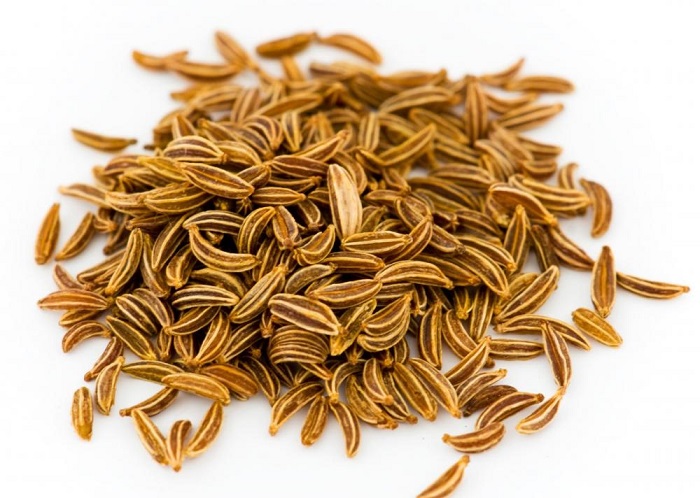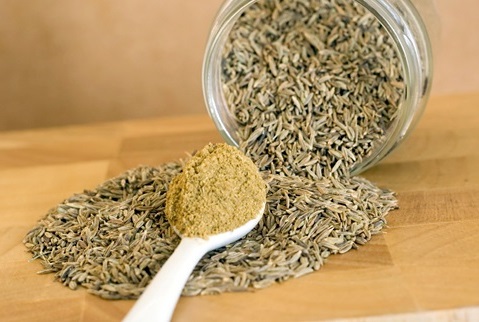Main Name: Cumin
Biological Name: Cuminum cyminum
Names in other languages: Comino (Spanish), Cumin (French), Jeera (Hindi), Jeeragham, Jeerakam (Tamil), Jeeragam, Jirakam, Nallajirakam (Malayalam), Jeelakarra (Telugu), Jiru (Gujarati), Jire (Bengali), Jire (Marathi & Oriya), Jeera (Punjabi), Zeera (Urdu)
Biological Name: Cuminum cyminum
Names in other languages: Comino (Spanish), Cumin (French), Jeera (Hindi), Jeeragham, Jeerakam (Tamil), Jeeragam, Jirakam, Nallajirakam (Malayalam), Jeelakarra (Telugu), Jiru (Gujarati), Jire (Bengali), Jire (Marathi & Oriya), Jeera (Punjabi), Zeera (Urdu)
Often children hate curries and soups that contain roasted or fried cumin seeds in them. Although they are miniscule and very tiny in size, they can serve as a hindrance. As a result, mothers are assigned with yet another duty of sorting out the cumin seeds aside before they serve the meals to the kids. While that was exactly what most of us did during our childhood, it’s only after we grew up that we realized the importance of every food served to us by our moms. Not just for taste, but for the umpteen benefits it has for our body. One such flavorful yet mild food, in fact a spice, is cumin. Valued for its distinctive aroma and nutritious flavor, cumin is the second most popular spice in the world after black pepper. A member of the parsley family, cumin seeds are oblong in shape, longitudinally ridged, and yellow-brown in color, similar to caraway, parsley and dill. Just as the spice is an important ingredient in stews, breads, curries, and ethnic dishes from across the world, so are its medicinal uses quite evident. Since centuries, this herb has been used for treating a number of ailments, both as whole dried seeds and in its powdered form. What follows from here are cumin’s top health benefits, with many more still to be researched on.
History
Indigenous to the upper portion of Egypt, the history of cumin dates back to more than 5000 years. Samples of cumin have been found in the tombs of Pharaohs and have been mentioned in the Old Testament. With the cultivation originating in Iran and the Mediterranean, cumin was used as a spice and for medicinal purposes. In the Middle Ages, cumin came to be known as one of the most common spices, a time when spices were comparatively very rare. It was considered as a sign of promoting love and fidelity. Cumin was kept in the pockets and carried along with people on their weddings. It was a noted spice in the ancient Greece and Rome, where the Greeks placed it on their dining tables. However, its popularity declined all over Europe during the Middle Ages, except in Spain and Malta. The Spanish and Portuguese colonists introduced cumin to the Americas and gradually it gained back its flavor and place in the European kitchens. Today, the spice is celebrated across the globe for its wonderful and delightful culinary and therapeutic purposes. It is mostly cultivated in parts of India, Iran, Uzbekistan, Tajikistan, Turkey, Morocco, Egypt, Syria, Mexico, Chile, China, Malta, Sicily and Saudi Arabia. Health Benefits of Cumin
Health Benefits of Cumin
Indigenous to the upper portion of Egypt, the history of cumin dates back to more than 5000 years. Samples of cumin have been found in the tombs of Pharaohs and have been mentioned in the Old Testament. With the cultivation originating in Iran and the Mediterranean, cumin was used as a spice and for medicinal purposes. In the Middle Ages, cumin came to be known as one of the most common spices, a time when spices were comparatively very rare. It was considered as a sign of promoting love and fidelity. Cumin was kept in the pockets and carried along with people on their weddings. It was a noted spice in the ancient Greece and Rome, where the Greeks placed it on their dining tables. However, its popularity declined all over Europe during the Middle Ages, except in Spain and Malta. The Spanish and Portuguese colonists introduced cumin to the Americas and gradually it gained back its flavor and place in the European kitchens. Today, the spice is celebrated across the globe for its wonderful and delightful culinary and therapeutic purposes. It is mostly cultivated in parts of India, Iran, Uzbekistan, Tajikistan, Turkey, Morocco, Egypt, Syria, Mexico, Chile, China, Malta, Sicily and Saudi Arabia.
 Health Benefits of Cumin
Health Benefits of Cumin- Cumin is extremely beneficial for digestive disorders and other related problems, such as biliousness, morning sickness, indigestion, atonic dyspepsia, diarrhea, malabsorption syndrome and flatulent colic. Cumin contains an aromatic organic compound called Cuminaldehyde, which activates the salivary glands, thereby helping in the digestion process.
- The major cause of piles is constipation which worsens with infections in the wound in the anal tract. Due to its dietary fiber content and carminative, stimulating, antifungal and microbial properties, cumin helps in the healing of infections or wounds in the digestive and excretory system.
- Cumin has been researched to possess detoxifying and chemo-preventive properties, which are important for accelerating the secretion of detoxifying and anti-carcinogenic enzymes from the glands. These compounds combine with vitamins A and C to prevent the risk of developing breast and colon cancer cells.
- Cumin acts as a stimulant and relaxant, both at the same time. Cumin does not only contain a sufficient amount of B-complex vitamins, it also helps in the digestion process, thereby inducing a sound sleep. These, in turn, have tranquilizing effects and help in overcoming insomnia.
- Due to the presence of caffeine and aromatic essential oils, cumin makes an ideal anti-congestive combination for people suffering from respiratory disorders, such as asthma, bronchitis, and so on.
- The onset of common cold frequently weakens our body, thereby declining our immune system. Cumin battles the viral infections responsible for common cold and cough formation. Rich in iron and vitamin C, cumin keeps the infections at bay and strengthens the immune system.
- The rich iron content in cumin makes it an essential component for producing hemoglobin, which transfers oxygen to all the cells of the body, the deficiency of which leads to anemia. As such, cumin can easily be incorporated into the daily diet of anemic people.
- Iron is necessary for nursing mothers, pregnant women and those undergoing menses. Cumin contains Thymol, which increases the secretion from glands, including breast milk secreted from mammary glands, extremely significant in lactating women.
- Cumin, along with milk and honey, is recommended for pregnant women during the entire period of pregnancy for healthy development of the fetus and facilitating easy childbirth.
- Vitamin E present in abundance in cumin keeps the skin young and glowing. It contains essential oils which have disinfectant and antifungal properties, thereby helping in the prevention of microbial and fungal infection from damaging the skin.
- Cumin is considered to be one of nature’s best overall body tonics. It helps in enhancing the rate of metabolism and facilitating the absorption of nutrients throughout the body.
- Cumin seeds are also beneficial for curing renal coli, boils, weak memory, lack of concentration, insect bites, swollen gums, mouth ulcers, acidity and bad breath.
Cumin Nutrition FactsAmount: 1 cup
Total Weight: 98 g
Total Weight: 98 g
| Nutrients | Amount |
| Basic Components | |
| Protein | 18 g |
| Water | 7.9 g |
| Ash | 7.4 g |
| Phytosterols | 67 mg |
| Calories | |
| Total Calories | 369 |
| Calories From Carbohydrate | 126 |
| Calories From Fat | 183 |
| Calories From Protein | 59 |
| Carbohydrates | |
| Total Carbohydrates | 44 g |
| Dietary Fiber | 10 g |
| Sugar | 2.2 g |
| Fats & Fatty Acids | |
| Total Fat | 22 g |
| Saturated Fat | 1.5 g |
| Monounsaturated Fat | 14 g |
| Polyunsaturated Fat | 3.2 g |
| Omega-3 Fatty Acids | 173 mg |
| Omega-6 Fatty Acids | 3.1 g |
| Vitamins | |
| Vitamin A | 1250 IU |
| Vitamin C | 7.6 mg |
| Vitamin E | 3.3 mg |
| Vitamin K | 5.3 mcg |
| Thiamin | 618 mcg |
| Riboflavin | 322 mcg |
| Niacin | 4.5 mg |
| Vitamin B6 | 428 mcg |
| Folate | 9.8 mcg |
| Choline | 24.2 mg |
| Minerals | |
| Calcium | 916 mg |
| Iron | 65 mg |
| Magnesium | 360 mg |
| Phosphorus | 491 mg |
| Potassium | 1.8 g |
| Sodium | 165 mg |
| Zinc | 4.7 mg |
| Copper | 853 mcg |
| Manganese | 3.3 mg |
| Selenium | 5.1 mcg |

http://www.tablespoon.com/posts/spicy-sunday-what-is-cumin/d052e975-5fdf-440f-8318-1eaede2ab519
How many calories in cumin seeds (per 100 gm)
Cumin seeds have about 375 calories per 100 gm of weight.
Cumin seeds have about 375 calories per 100 gm of weight.
How to Buy Cumin Seeds
- Cumin can be found in markets all round the year in the form of seeds and powdered form. But it is best to buy cumin seeds since cumin powder is likely to lose its texture and flavor with time.
- Pick up a cumin seed and squeeze it between your thumb and index finger. If it releases pepper flavor, it is an indication of good quality cumin seeds.
- It is advised that you always buy whole cumin seeds since the powdered variety can sometimes contain adulterated spicy powders.
Cumin Storage Tips
- Store cumin seeds in airtight containers in a cool, dry, dark place. This way, they keep fresh for about one year or so.
- Ground or powdered cumin should be stored in sealed containers away from light and heat. Use it within six months of purchase and replace once it loses its pungency or becomes clumpy or dull in color.
- To extend the life of ground cumin, store it in the refrigerator, but use it as soon as possible since as it will lose its flavor quickly.

